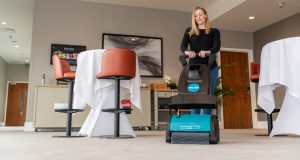With more employers encouraging – and even mandating, like Elon Musk and Apple have recently – that employees return to the office full time, or at least in a hybrid setting, what should companies be considering?
For one, the level of hygiene, says a spokesperson for domain and hosting providers, Fasthosts. “Our company works a hybrid model, so we wanted to find out how clean office equipment actually is. Using Hygiena’s UltraSnap Surface ATP Test, we analysed the RLU (Relative Light Unit) results. What did we find? Get those antibacterial wipes at the ready…”
- Your desk is almost three times dirtier than the standard toilet seat (RLU 209), with a horrifyingly high average RLU score of 606
- Your keyboard (RLU 382) is a highly favourable environment for microorganisms, and likely to harbour almost as many germs as your kitchen bin (RLU 392).
- Registering an RLU score of 260, your mouse is home to more lingering germs than your door mat (RLU 173)
- Your desk chair (RLU 310) is more likely to harbour germs than your toilet seat (RLU 209)
They added: “Starting a study like this, we wondered if we’d get shocking results. And by comparing toilet seats, door mats and kitchen bins to common desk items, we were surprised to find just how dirty desks can actually be. Even dirtier than the standard toilet seat, our findings have shown.”
Speaking to Karim Samani, MD of TechDisinfect, Fasthosts wanted to know how office desks can harbour so much more germs compared to toilet seats and kitchen bins. Samani said: “Viruses, germs and bacteria can be transmitted around the home very easily, but our workplaces are potentially a much bigger hazard. Everything from coffee cups to keyboards can harbour infection.
“It’s not just high-traffic communal areas that could be harbouring a virus. Some viruses can survive on surfaces such as metals and plastics for up to a day, meaning everyday I.T. equipment – such as laptops, tablets, phones, keyboard, mice, printers etc, – can be hotspots for transmission.
“Desks and office items can be four times dirtier than a toilet seat because we’re spending so much more time with them. People tend to eat and drink at their desks, never thinking about cleaning up afterwards. Employees also don’t tend to give serious consideration to disinfecting regularly, and are often reliant on the business to take charge of the cleaning.
“It’s in a company’s interest to take rigorous cleaning procedures seriously, as two-thirds of office workers are at risk of illness thanks to the nasty bugs hiding in the workspace, as tests have shown. The average desktop harbours 20,961 germs per square inch in addition to 3,295 on the keyboard and 1,676 on a mouse. The phone can also harbour a staggering 25,127 – that’s 127 more germs per square inch than on a toilet seat. Based on our experience, we give an RLU score of >1000 to an average desk, which is filthy.
For the full findings, head to the dirty desks study, complete with an insightful, interactive microscope feature to examine exactly how dirty your average desk can get.
Samani offers some top tips. He said: “Ways to keep on top of germ control is to put stringent cleaning practices in place. Encouraging individual employees to take more control over their own desks is ideal, but it’s not the best solution when people get complacent. Professional cleaning services are a big help and provide the most efficient method as trained experts can help protect staff through rigorous cleaning of equipment – even I.T. equipment can be deep-cleaned. A schedule can be put in place so that desks and equipment are routinely and thoroughly cleaned to keep nasty germs at bay, reducing the risk of bugs and sickness spreading so easily.”





